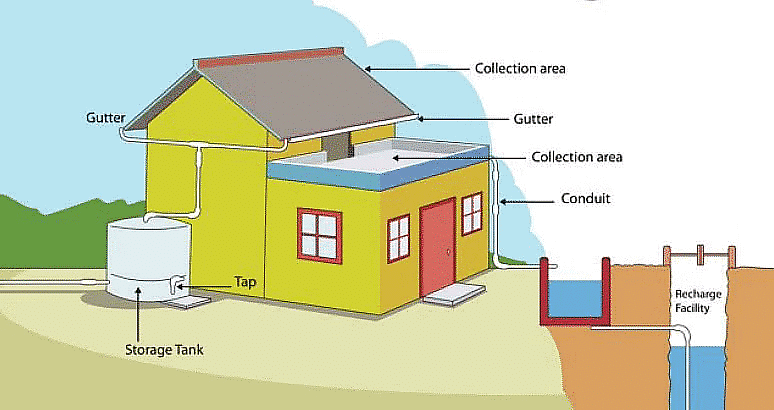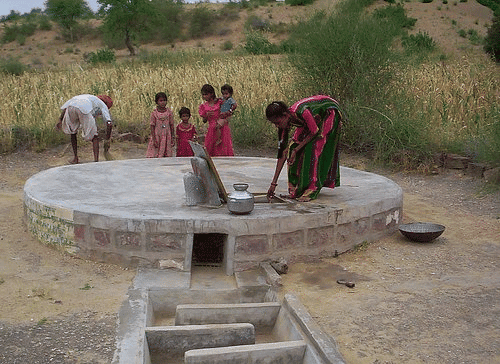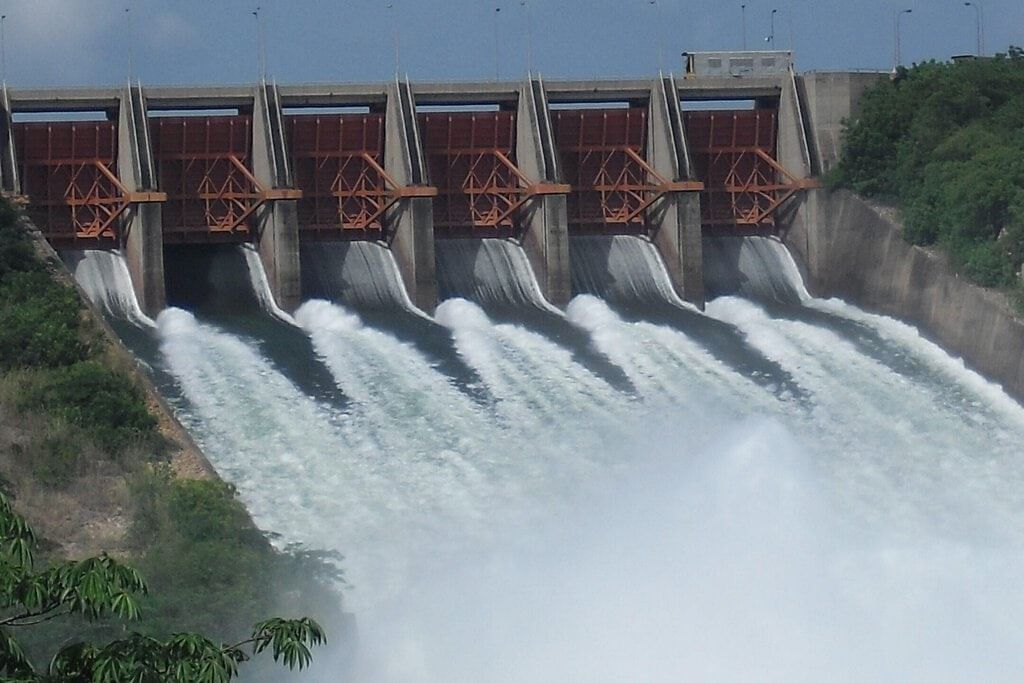Class 10 Geography Chapter 3 Extra Question Answers - Water Resources
Q1. What is rainwater harvesting? Explain any two different methods of rainwater harvesting in different regions of India.

Ans: Rainwater harvesting is a method of collecting and storing rainwater for various uses. It helps conserve water and is especially important in regions with limited water supply.
- Hill Region: In the western Himalayas, people construct diversion channels known as guls or kuls. These channels direct rainwater for agricultural purposes, allowing effective use of this precious resource.
- Arid Region: In Rajasthan, many houses have underground tanks as part of a rooftop rainwater harvesting system. Rainwater collected from sloping roofs flows through pipes into these tanks, providing a reliable water source.
Q2. What is a multipurpose river valley project? Give any four objectives of the multipurpose river valley project.
Ans: A multipurpose river valley project involves constructing a dam on a river to store water for various uses. The stored water can be utilised for:
- Flood control: Regulating water flow helps to prevent flooding.
- Hydropower generation: Producing electricity for industries and homes.
- Irrigation: Providing water for agriculture, which boosts productivity and expands cultivated areas.
- Soil erosion prevention: Reducing the loss of soil through controlled water management.
Q3. Discuss how rainwater harvesting in semi-arid regions of Rajasthan is carried out.

Ans: Rainwater harvesting in the semi-arid regions of Rajasthan is implemented through various traditional methods:
- In towns like Bikaner, Phalodi, and Barmer, most homes have underground tanks, known as tankas, for storing drinking water.
- These tanks can be quite large; for example, one tank in Phalodi measures 6.1 metres deep, 4.27 metres long, and 2.44 metres wide.
- The tankas are part of a well-designed rooftop rainwater harvesting system, built within the house or courtyard.
- Rainwater collected from sloping roofs flows through pipes into these underground tanks.
- This system allows households to store significant amounts of rainwater, providing a reliable source of drinking water.
Q4. Describe three traditional methods of rainwater harvesting practised in India.
Ans:
In hilly regions, people construct diversion channels known as guls or kuls to manage rainwater for agriculture.
In Rajasthan, the practice of rooftop rainwater harvesting is common, where rainwater is collected from roofs for drinking.
In Bengal, people create inundation channels to irrigate their fields during the rainy season.
In arid and semi-arid regions, agricultural fields are transformed into rainfed storage structures to retain water.
Q5. Give three reasons for water scarcity in post-independence India.
Ans: Three reasons for water scarcity in post-independence India are:
- Intensive industrialisation and urbanisation have significantly increased water demand.
- Large urban centres with dense populations have heightened the need for water.
- The population explosion after independence has led to the overexploitation of groundwater for irrigation.
Q6. ‘Three-fourths of the earth’s surface is covered with water but there is still scarcity of water across the globe.’ Explain giving three reasons.
Ans: Water scarcity is caused by several factors:
- Variation in water availability: Water resources differ across regions and seasons, largely due to changes in rainfall.
- Urbanisation: Rapid growth of cities increases water demand, putting pressure on existing supplies.
- Population growth: A rising population requires more water for daily use and food production.
- Industrialisation: Industries consume large amounts of water and need it for electricity generation.
- Income levels: Higher incomes lead to increased water consumption.
Despite the fact that 96.5% of the world's water is in oceans, only 2.5% is fresh water. Of this, nearly 70% is trapped in ice and glaciers, while less than 30% is groundwater.
Q7. How have industrialisation and urbanisation aggravated water scarcity in India?
Ans: Industrialisation and urbanisation have worsened water scarcity in India through several key factors:
- Increased Demand: Large industries consume significant amounts of freshwater and require energy, often sourced from hydroelectric power.
- Urban Growth: Expanding urban centres with dense populations elevate water and energy needs, leading to over-exploitation of water resources.
- Groundwater Depletion: Many urban areas rely on groundwater pumping, which depletes fragile water supplies.
Overall, these factors contribute to a critical situation where water resources are being rapidly exhausted.
Q8. Why is the conservation and management of water resources important? Give any three reasons.
Ans: The conservation and management of water resources are essential for several reasons:
- Growing population: As the population increases, the demand for water also rises, necessitating effective management of water availability.
- Increasing urbanisation: More people are moving to cities, which intensifies the need for water. Urban areas often overuse and pollute water resources, highlighting the need for conservation.
- Industrialisation: Industries are major consumers of water, leading to overexploitation. Without proper conservation efforts, sustaining water resources will become increasingly difficult.
Q9. Explain any three disadvantages of multipurpose projects.
Ans:
- Large areas submerged: These projects often flood vast regions, leading to the destruction of wildlife and forests.
- Displacement of people: Many individuals are forced to leave their homes, creating significant rehabilitation challenges.
- Impact on aquatic life: The natural flow of rivers is disrupted, affecting aquatic ecosystems and biodiversity.
Q10. Why are different water harvesting systems considered a viable alternative both socio - economically and environmentally in a country like India?
Ans: Different water harvesting systems are essential in India due to the country's diverse geography and climate. Here are some key methods:
- Hilly regions: Water is diverted for irrigation using kuls or guls, which are cost-effective.
- Arid regions: In places like Rajasthan, rainwater is collected from rooftops and stored underground, requiring minimal effort.
- Villages: Agricultural fields are transformed into ponds to collect rainwater, making these methods practical and efficient.
Overall, these systems are simple, economical, and well-suited to local conditions.
Q11. How far have the multipurpose projects been able to achieve their purpose for which they were made? Explain.
Ans: Multipurpose river valley projects have achieved some of their intended goals:
- Irrigation has improved significantly.
- Power generation is a notable success.
- However, there are ongoing concerns regarding their overall effectiveness.
Q12. Why is the need for water increasing day by day? Explain three reasons.
Ans: The demand for water is increasing due to several factors:
- Industrialisation: Rapid growth in industries requires significant amounts of water for production and cooling processes.
- Population growth: A larger population leads to higher domestic water needs and increased agricultural demands to produce more food.
- Urbanisation: Expanding urban areas with dense populations create greater pressure on water resources for daily living and sanitation.
Q13. Give an account of any three hydraulic structures of ancient India.
Ans: Ancient India was known for its impressive hydraulic structures. Here are three notable examples:
- Sringaverapura: In the first century B.C., this site near Allahabad featured a sophisticated water harvesting system that channelled floodwaters from the Ganga.
- Chandragupta Maurya's Era: During this period, extensive construction of dams, lakes, and irrigation systems took place across the region.
- Bhopal Lake: Built in the 11th century, this was one of the largest artificial lakes of its time, showcasing advanced engineering.
Q14. ‘Large multi-purpose projects also lead to land degradation.’ Explain.
Ans: Large multi-purpose projects lead to land degradation.
- The regulation and damming of rivers disrupt their natural flow.
- This causes poor sediment flow and excessive sedimentation at the bottom of reservoirs.
- As a result, stream beds become rockier, harming aquatic habitats.
- Dams fragment rivers, making it difficult for fish and other aquatic life to migrate.
- Reservoirs created on floodplains submerge existing vegetation and soil, leading to its decomposition over time.
Q15. What is a dam? How are dams classified?

Ans: A dam is a barrier built across a river or stream to control the flow of water. It can create a reservoir, lake, or impoundment. The term "dam" often refers to the reservoir rather than the physical structure itself.
Dams are classified based on:
- Structure: Types include timber dams, embankment dams, and masonry dams, each with various subtypes.
- Purpose: Dams can serve multiple functions, such as irrigation, flood control, and hydroelectric power generation.
- Height: They are categorised as low, medium, or high dams, with large and major dams being significant classifications.
Long Answer Type Questions
Q1. How was water conserved in ancient India? Give any four examples in support of your answer.
Ans: Ancient India demonstrated remarkable skills in water conservation through various hydraulic structures. These included:
- Sringaverapura: In the first century BC, this location near Allahabad had an advanced water harvesting system that channelled floodwaters from the Ganges.
- Chandragupta Maurya's Era: During this period, extensive construction of dams, lakes, and irrigation systems took place.
- Kalinga and Other Regions: Evidence of sophisticated irrigation works has been found in areas like Kalinga (Odisha), Nagarjunakonda (Andhra Pradesh), and Kolhapur (Maharashtra).
- Hauz Khas Tank: Constructed in the 14th century by Iltutmish, this tank was designed to supply water to the Siri Fort area in Delhi.
Q2. “In recent years, the multi-purpose projects and large dams have come under great scrutiny.” Give reasons.
Ans: In recent years, multi-purpose projects and large dams have faced significant scrutiny for several reasons:
- River Regulation: Damming rivers disrupts their natural flow, leading to poor sediment transport and excessive sedimentation in reservoirs. This results in rockier stream beds and negatively impacts aquatic habitats.
- Fragmentation: Dams fragment rivers, hindering the migration of aquatic species, particularly during spawning seasons.
- Vegetation Submersion: Reservoirs created on floodplains submerge existing vegetation and soil, causing their decomposition over time.
- Community Displacement: Large-scale projects often displace local communities, forcing them to abandon their land and livelihoods, leading to increased hardship.
- Social Inequality: The benefits of these projects tend to favour landowners and industrialists, widening the gap between the wealthy and the poor.
- Ecological Impact: Irrigation changes cropping patterns, pushing farmers towards water-intensive crops, which can lead to soil salinisation.
Q3. Explain the ecological problems being faced due to the multi-purpose river projects.
Ans: Multi-purpose river projects and large dams have come under scrutiny for several ecological issues:
- Altered River Flow: Damming rivers disrupts their natural flow, leading to poor sediment transport and excessive sedimentation in reservoirs. This results in rockier stream beds, harming aquatic habitats.
- Fragmentation: Dams fragment rivers, making it challenging for aquatic species to migrate, particularly during spawning seasons.
- Vegetation Loss: Reservoirs created on floodplains submerge existing vegetation and soil, causing their decomposition over time.
- Displacement: Large-scale projects often displace local communities, forcing them to abandon their land and livelihoods, while benefiting landowners and industrialists.
- Social Inequality: These projects widen the gap between wealthy landowners and poorer communities, leading to conflicts over water usage. For instance, in Gujarat, farmers have protested against prioritising urban water supply during droughts.
- Cropping Changes: Irrigation from these projects has altered cropping patterns, pushing farmers towards more water-intensive and commercial crops, which can lead to soil salinisation.
Q4. Write the features of the tankas built in the houses of Bikaner, Phalodi and Banner.
Ans: Features of Tankas in Bikaner, Phalodi, and Barmer
- Location: Tankas are primarily found in the semi-arid and arid regions of Rajasthan, especially in Bikaner, Phalodi, and Barmer.
- Construction: These underground tanks are designed to store drinking water and can be as large as a room. For example, one household in Phalodi has a tanka measuring 6.1 metres deep, 4.27 metres long, and 2.44 metres wide.
- Rainwater Harvesting: Tankas are integral to a well-developed rooftop rainwater harvesting system, typically built within the main house or courtyard.
- Water Collection: They are connected to sloping roofs via pipes, allowing rainwater to flow from the rooftops into the tankas.
Q5. Why is rooftop rainwater harvesting important in Rajasthan? Explain.
Ans: Rooftop rainwater harvesting is crucial in Rajasthan due to its unique climatic challenges:
- Rajasthan is a desert region with limited rainfall, primarily occurring from June to September.
- Many wells have dried up, leading to a severe water crisis for residents.
- To combat this, traditional underground tankas are built in homes to store rainwater.
- These tankas are integral to the rooftop rainwater harvesting system, providing a reliable drinking water source during dry periods, especially in summer.
- Rainwater is the purest form of natural water, essential in a region lacking perennial rivers.
- Additionally, rooftop rainwater harvesting helps keep homes cool during the hot summer months.
|
65 videos|517 docs|79 tests
|
FAQs on Class 10 Geography Chapter 3 Extra Question Answers - Water Resources
| 1. What are the main sources of water resources in India? |  |
| 2. How does water scarcity affect agriculture in India? |  |
| 3. What measures can be taken to conserve water resources? |  |
| 4. What are the impacts of urbanization on water resources? |  |
| 5. How is water pollution a threat to water resources? |  |























